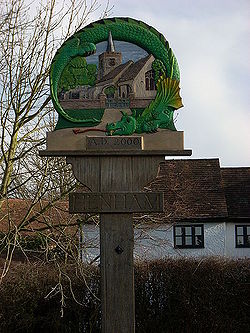Henham dragon
The Henham dragon is the popular name for a large serpent-like creature (dragon) sighted near Henham, Essex, England in 1669.[1] Henham or Henham-on-the-Hill is a small village with a current population of about 1250. It is located in the north-west part of Essex about seven miles south of the historical town of Saffron Walden where a flying reptile called a cocatrice was killed around the same time.[2]
The pamphlet at left about the Henham Dragon was circulated in 1669, in Essex England regarding the recent sightings of a large reptile. Although seen by numerous people, attempts by local villagers to shoot the beast were unsuccessful. It reads:
| “ | The Flying Serpent. Or: Strange News out of Essex. Being: A true Relation of a Monstrous Serpent which hath divers times been seen at a Parish called Henham-on-the-Mount within 4 miles of Saffron Walden. Showing the length, proportion and bigness of the Serpent, the place, where it commonly lurks, and what means hath been used to kill it. Also a discourse of other Serpents, and particularly of a cocatrice killed at Saffron Walden. | ” |
The interior of the pamphlet continues:
| “ | The place of his abode and where he hath been oftentimes seen, is called Henham, but most commonly Henham on the Mount, the town standing upon a hill, having many fair farms and granges belonging to it, in one of which named The Lodge, near to a wood called Birch-wood, by reason of the many birches growing there, in a pasture-ground close by the same, hath this monstrous serpent been often seen as he hath lain upon the sides of a bank, beaking and stretching himself out upon the same, at such time as Sol did parch the earth with his resulgent beams.
The first time that he was seen was about the 27 or 28 of May last, a gentleman’s way lying by the place where this serpent keeps his station, as he rid carefully on, expecting to receive no hurt as he intended none, on a sudden this Serpent assailed his horse, affrighting the rider so much with his monstrous proportion and bold courage to give such an onset, that all in a maze he spurred his horse, who almost as much afraid as his master, with winged speed hafted away, glad that they had escaped such an eminent danger. Being come home he acquaints his friends and neighbours with what he had seen of this monstrous serpent, especially makes it known to a neighbour in whose grounds this serpent doth lurk, wishing him to beware of his cattle, and to use his best indeavour for destroying it, least by protraction of time it might do much mischief when had I wist would be but small comfort to him for the losses he might sustain. Not long after two men of the same parish walking that way, espied this serpent as he lay on a hillock beaking himself again in the sun, where they beheld his full proportion, being as near as they could guess 8 or 9 foot long, the smallest part of him about the bigness of a man's leg, on the middle as big as a man's thigh, his eyes were very large and piercing, about the bigness of a sheep’s eye, in his mouth he had two row of teeth which appeared to their sight very white and sharp, and on his back he had two wings indifferent large, but not proportionable to the rest of his body, they judging them not to be above two handfuls long, and when spreaded, not to extend from the top of one wing to the utmost end of the other above two foot at the moll, and therefore altogether too weak to carry such an unwieldy body. These men though armed with clubs and staves, yet durst not approach to strike this serpent, neither it seems was the serpent afraid of them, for railing himself upon his breast about the heighth of two foot, he stood looking on them as daring them to the encounter...[1] |
” |
Dragons
Criticisms
Doubts about the sightings were raised in the late 1990's when Alison Barnes published a booklet titled 'The Ingenious William Winstanley' - poet, journalist, bookseller, historian and novelist of nearby Saffron Walden and Quendon - 1628 - 1698.
Barnes suggests that William Winstanley, who published the above pamphlet, perpetrated a hoax on the citizenry by the creation of "a hollow nine-foot wood and canvas dragon or "flying serpent" activated by a man which made fleeting appearances in and around Birch Wood, Henham throughout that summer and caused great excitement and mystification in the neighbourhood."
Although the contents of the pamphlet were verified by a churchwarden, a constable, and five other solid citizens, Barnes asserts that the witnesses were close friends of Winstanley who went along with the hoax. She also assumes that the pamphlet was probably on sale in William's Walden bookshop adding motivation for the fraud.[1]
References
| |||||||||||||||||



